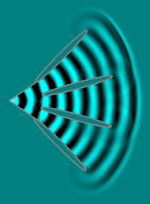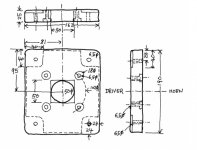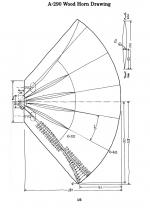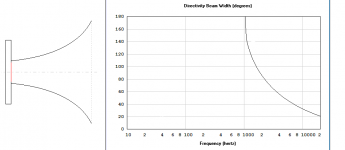Horizontal on- and off-axis frequency responses
All frequency responses were measured at a distance of 40 inches (1 m) to the exit of the Radian 745NEO Be drivers. I rotated each horn clockwise and counter-clockwise in 10 degrees increments about the origin. What origin to use? I chose the exit of the driver as the rotation axis. This simplifies keeping the distance between microphone and driver constant, and also implies that at +/- 50 degrees off-axis the microphone is aimed outside the axis of the side wall of the Yuichi horn - something I was curious to measure.
A signal level at the amplifier output of 0.335 Vrms was applied directly to the driver without protection capacitor nor filtering. Each off-axis curve is the RMS average of the two curves obtained X degrees to the right and left of the horn axis. This evens out small differences caused by imperfect driver centering and asymmetric fins positioning within the horn throat. 1/24 octave smoothing was applied to the curves.
Voici, for the JMLC 425 horn, the horizontal dispersion from 0 to 50 degrees in 10 degree increments.

Recall that this design makes no directivity claim. The variation in response within a horizontal fanout of +/- 30 degrees (60 degrees total) is less than 4 dB up to 2kHz, then increases to 8 dB at 4 kHz, 14 dB at 10 kHz and 22 dB at 17 kHz. At +/-40 and +/-50 degrees off-axis the falloff is more severe. The spreading of the curves is well-behaved, without obvious anomalies.
And the results of the same test performed on the Yuichi 290 horn and the "stubby" throat adaptor.

The angular variation in response within a horizontal fanout of +/- 30 degrees is less than 4 dB all the way up to 20 kHz. At +/-40 degrees off-axis the response tracks that of the main beam but at a level reduced by 2 to 3 dB up to 20 kHz. At +/-50 degrees off-axis the response departs from that of the main beam above 1.5 kHz and gradually falls off. The reader will recall that this is measuring past the axis of the side wall of the horn.
For completeness, here are the horizontal response measurements when the driver is equalized.


The filter-EQ designed for the JMLC does not fare too badly on the Yuichi. This looks worthy of a listen as is, biamplified so that I can attenuate the woofer to match the reduced level of the Yuichi.
A note on the 0, 10, 20 ... 50 degrees angles. Measuring the angle at the driver exit produces a "worst case" plot for a given angle value compared to, as an example, measuring from the center of the horn mouth. Another way to look at it is choosing the rotation angle. Maybe there is a standard? The shorter the measurement distance, the greater the difference can be. This table compares angles for the geometry used here (40 inch to driver exit, 12 inch long JMLC and 16 inch long Yuichi) if measured from the driver exit (as was done for the plots above) versus the horn mouth.

Please continue to comment, especially if you see surprises in the data presented so far, as I find this very educative.
All frequency responses were measured at a distance of 40 inches (1 m) to the exit of the Radian 745NEO Be drivers. I rotated each horn clockwise and counter-clockwise in 10 degrees increments about the origin. What origin to use? I chose the exit of the driver as the rotation axis. This simplifies keeping the distance between microphone and driver constant, and also implies that at +/- 50 degrees off-axis the microphone is aimed outside the axis of the side wall of the Yuichi horn - something I was curious to measure.
A signal level at the amplifier output of 0.335 Vrms was applied directly to the driver without protection capacitor nor filtering. Each off-axis curve is the RMS average of the two curves obtained X degrees to the right and left of the horn axis. This evens out small differences caused by imperfect driver centering and asymmetric fins positioning within the horn throat. 1/24 octave smoothing was applied to the curves.
Voici, for the JMLC 425 horn, the horizontal dispersion from 0 to 50 degrees in 10 degree increments.
Recall that this design makes no directivity claim. The variation in response within a horizontal fanout of +/- 30 degrees (60 degrees total) is less than 4 dB up to 2kHz, then increases to 8 dB at 4 kHz, 14 dB at 10 kHz and 22 dB at 17 kHz. At +/-40 and +/-50 degrees off-axis the falloff is more severe. The spreading of the curves is well-behaved, without obvious anomalies.
And the results of the same test performed on the Yuichi 290 horn and the "stubby" throat adaptor.
The angular variation in response within a horizontal fanout of +/- 30 degrees is less than 4 dB all the way up to 20 kHz. At +/-40 degrees off-axis the response tracks that of the main beam but at a level reduced by 2 to 3 dB up to 20 kHz. At +/-50 degrees off-axis the response departs from that of the main beam above 1.5 kHz and gradually falls off. The reader will recall that this is measuring past the axis of the side wall of the horn.
For completeness, here are the horizontal response measurements when the driver is equalized.
The filter-EQ designed for the JMLC does not fare too badly on the Yuichi. This looks worthy of a listen as is, biamplified so that I can attenuate the woofer to match the reduced level of the Yuichi.
A note on the 0, 10, 20 ... 50 degrees angles. Measuring the angle at the driver exit produces a "worst case" plot for a given angle value compared to, as an example, measuring from the center of the horn mouth. Another way to look at it is choosing the rotation angle. Maybe there is a standard? The shorter the measurement distance, the greater the difference can be. This table compares angles for the geometry used here (40 inch to driver exit, 12 inch long JMLC and 16 inch long Yuichi) if measured from the driver exit (as was done for the plots above) versus the horn mouth.
Please continue to comment, especially if you see surprises in the data presented so far, as I find this very educative.
Last edited:
Only in part. The horizontal should kick out directly after the vanes, but it continues the same as it was on it's own. Instead, the vertical takes over and increases expansion there.The Challenge is that the wave front should be coherent at the exit where the five channels combine.
This horn is a waveguide theory enigma. It follows a loading expansion in an arbitrary way and that's where it gets complicated.
It would be best if it were a cone with no vanes and the correct starting wavefront.The five sub channels of course provide a better horizontal dispersion as you can see this as five different horns radiating in a conical bell.
As it is, the vanes create an expansion. Expanding horns diffract, and in this case the diffraction is distributed between the cells...

I do read yours, do you read mine? ;-)Sorry, do you really read my posts or do you only repeat some historical info? It is for sure possible to design a throat adapter that is optimal for the Radian 745NEO. This is again simple math from a round 1.4" driver exit which has a distinct surface area and the 50x50mm Yuichi throat surface area. Using the desired T value you can exactly calculate the length of the adapter and also the coordinates at each increment of the adapter.
I wasn't talking about the throat adapter. Sure, you can make one of those to go down to the 1.4" driver exit with the same Fc and T of the horn.
I was referring to the internal geometry of the compression driver, i.e. from the diaphragm to the 1.4" exit.
None of the Yuichi Arai horns have 40x50mm throats.Throat Adaptor
The throat of my Yuichi 290 measures 1 31/32 x 1 9/16 inch (50 x 40 mm). The throat adaptor that I used for testing has an entrance diameter of 1 3/8 inch (35 mm). So the surface expands from 1.5 to 3 inch^2 (a factor of two) over a length of just 7/8 inch (2.3 cm).
View attachment 1136062
View attachment 1136064
The horns came with another throat adaptor that has an entrance diameter of 2 inches and length of 3/4 inch. Alas there is no expansion of area at all along that length. So adding a round 1.4 to 2 inch adaptor in front of this one does not seem ideal, however this might load the driver better than using the "stubby" one. I would need to get that round-to-round adaptor to try this.
Since my horizontal measurements are already made using the "stubby" throat adaptor , let me share them with the caveat that the driver-to-horn adaptor was not optimized.
Maybe what you have is a clone of the TH-4001 instead? That one does have a 40x50 "pinched" throat, and a very short round 50mm to rectangular 40x50mm throat adapter with no expansion at all.
Horses for courses.
Nice simulation. Would you please more info about the sw used and the workflow to do such simulations?Only in part. The horizontal should kick out directly after the vanes, but it continues the same as it was on it's own. Instead, the vertical takes over and increases expansion there.
This horn is a waveguide theory enigma. It follows a loading expansion in an arbitrary way and that's where it gets complicated.
It would be best if it were a cone with no vanes and the correct starting wavefront.
As it is, the vanes create an expansion. Expanding horns diffract, and in this case the diffraction is distributed between the cells...
View attachment 1136125
Agree, a point source into a conical horn will give optimal results. And this seems the general misconception how people look at TH4001 or Yuichi as we do not have a point source and this is the point where the channel path lengths are no more equal to combine coherently and nor more to combine as a spherical wave front at fin end.
Throat Adaptor
The throat of my Yuichi 290 measures 1 31/32 x 1 9/16 inch (50 x 40 mm). The throat adaptor that I used for testing has an entrance diameter of 1 3/8 inch (35 mm). So the surface expands from 1.5 to 3 inch^2 (a factor of two) over a length of just 7/8 inch (2.3 cm).
View attachment 1136062
View attachment 1136064
The horns came with another throat adaptor that has an entrance diameter of 2 inches and length of 3/4 inch. Alas there is no expansion of area at all along that length. So adding a round 1.4 to 2 inch adaptor in front of this one does not seem ideal, however this might load the driver better than using the "stubby" one. I would need to get that round-to-round adaptor to try this.
Since my horizontal measurements are already made using the "stubby" throat adaptor , let me share them with the caveat that the driver-to-horn adaptor was not optimized.
For sure, your current adapter is way too short to preserve loading.
But as you described there should be round adapter available from 1.4" to 2" of about 5cm length then you end up in a better region.
But is strange, you wrote your adapter is 50x40mm but Yuichi is 50x50mm fron the original plans:

I know that the TH4001 has about 50x40mm entry. Do you have a TH4001? Could you make a photo of the horn from top where we see it's outer flare?
http://www.falstad.com/ripple/Nice simulation. Would you please more info about the sw used and the workflow to do such simulations?
You wrote that the Radian 745NEO is a mismatch and implied that it will not work together with the Yuichi and I replied that I doubt that. What you wrote are alternative facts to call this rapid flare rate as the driver has only 10 degrees exit angle from the data sheet. This is near to the ideal for such horns. A little bit smaller would even be better.I do read yours, do you read mine? ;-)
That's likely due to a mismatch with the internal geometry of the Radian 745NEO driver (which is probably characterized by a somewhat "rapid flare" throat).
..."keen" is not an appropriate word to describe it but I like consistent designs. One of the main reasons to introduce the fins is to preserve acoustic loading wrt a given T value. Why abandon this with a suboptimal throat adapter? But it is interesting why you point on this because this thread title is about two horns which provide from their design high acoustic loading. And I am not here to defend these designs. I would like to help Pierre to reach a perfect setup of his driver together with his new horn.
Yes, the vertical i such historic horns is a compromise. But one could use other flares which give similar loading properties but better directivity.
Yes, the vertical i such historic horns is a compromise. But one could use other flares which give similar loading properties but better directivity.
Well, I believe I have egg on my face. Indeed it looks like what we have here is not a pair of Yuichi 290 as advertised, but TH-4001 clones! Wow! I should have checked...But is strange, you wrote your adapter is 50x40mm but Yuichi is 50x50mm fron the original plans:
View attachment 1136161
I know that the TH4001 has about 50x40mm entry. Do you have a TH4001? Could you make a photo of the horn from top where we see it's outer flare?
Looking at the posted drawings yesterday morning I did notice that the fins on my horns appear shorter than on the Yuichi blueprint. No wonder.
I am still happy measuring and trying them (TH-4001) for they have already been a great learning experience. Thanks to all. I will post another photo later today.
Last edited:
I wasn't aware that the Radian 745Neo had a 10 degree internal conical exit angle. I'd (wrongly, it seems) assumed that it was like most other modern drivers, with a much wider exit angle. My bad.You wrote that the Radian 745NEO is a mismatch and implied that it will not work together with the Yuichi and I replied that I doubt that. What you wrote are alternative facts to call this rapid flare rate as the driver has only 10 degrees exit angle from the data sheet. This is near to the ideal for such horns. A little bit smaller would even be better.
No problem. I got the exit angle from the Alu datasheet as in the corresponding Be datasheet the exit angle is missing but I am quite sure that the difference is only the diaphragm. Agreed that not many modern drivers have such a "narrow" exit angle.

Well, I believe I have egg on my face. Indeed it looks like what we have here is not a pair of Yuichi 290 as advertised, but TH-4001 clones! Wow! I should have checked...
Looking at the posted drawings yesterday morning I did notice that the fins on my horns appear shorter than on the Yuichi blueprint. No wonder.
I am still happy measuring and trying them (TH-4001) for they have already been a great learning experience. Thanks to all. I will post another photo later today.
This is not really a big issue wrt the performance. I own the TH4001 myself and it is a very good sounding horn. For 1.4" or 1.5" drivers you need an appropriate adapter. The biggest difference is that Yuichi has an additional horizontal flare so it should show little less midrange narrow.
Quite a difference notably on-axis below 2kHz! Measurements at 5m... must be quite a room or outdoors.
Is this what you wanted to see?Could you make a photo of the horn from top where we see it's outer flare?
Throat adaptation
So loading matters a great deal and post #1 measurements on the TAD TH4001 show that the low frequencies are not what they could be. Noticing a strange dip at 725 Hz was a sign. Here I summarize my understanding and possible next steps to address this.
Driver is Radian 745NEO: 1.4 inch, 10 degrees exit angle
Horn is TAD TH4001: T = 0.7, with 0 degree vertical throat angle, and (unknown?) degree horizontal throat angle.
A menagerie of real and imaginary throat options:
A) "Stubby" throat adaptor
Input: round diameter 1.4 inch (35.56 mm)
Exit: rectangular 40 x 50 mm
Length: 15/16 inch (24 mm)
Equivalent conical angle: 17.1 degrees
T: ?
B) "2 inch" TAD adaptor
Input: round diameter 50 mm
Exit: rectangular 40 x 50 mm
Length: 20 mm
Equivalent conical angle: 0.5 degree
T: ?
Note that the vertical angle is negative to bring down height from 50 to 40 mm.
C) "Ubiquitus" Eminence HA14-2 throat adaptor
Input: round diameter 1.4 inch (35.56 mm)
Exit: round diameter 2 inch (50.8 mm)
Length: unsure, but from photos approx 50 mm?
Angle: < 10 degree if length is > 41 mm
T: ?
D) "Dream" throat adaptor for above driver
Input: round diameter 1.4 inch (35.56 mm)
Exit: rectangular 40 x 50 mm
Length: likely < 41 mm, depends on exit angle(s)
Angle: 10 degrees at input, TBD ideally same as TH4001 at output
T: 0.7 if geometry permits?
E) "Easier" conical throat adaptor continuing Radian exit angle
Input: round diameter 1.4 inch (35.56 mm)
Exit: round diameter 50 mm
Length: 41 mm
Angle: 10 degree
T: infinity
I am presently testing A) which is too short. B) is too large. I ordered C) to put in front of B) as a quick fix to better load the driver, especially at lower frequencies. Am I on the right track here?
Does anyone know the horizontal angle at the input/throat of the TH4001? Then perhaps a DIY version D) would be viable, transitioning size, T and round to rectangular geometry all at once?
Another attraction of D) would be that the height could progress from 35.56 mm to 40 mm gradually instead of going from 35.56 to 50.8 back to 40 as is the case when using a 1.4 inch driver with B).
E) is an easy way out for use with B). Probably some improvement compared to C) and B)? Not convinced this is worthy making.
Going back to option D), anybody can recommend a source for custom throat adapters? If all else fails I can carve this out of wood when the outside temperature warms up, but it will take a while!
So loading matters a great deal and post #1 measurements on the TAD TH4001 show that the low frequencies are not what they could be. Noticing a strange dip at 725 Hz was a sign. Here I summarize my understanding and possible next steps to address this.
Driver is Radian 745NEO: 1.4 inch, 10 degrees exit angle
Horn is TAD TH4001: T = 0.7, with 0 degree vertical throat angle, and (unknown?) degree horizontal throat angle.
A menagerie of real and imaginary throat options:
A) "Stubby" throat adaptor
Input: round diameter 1.4 inch (35.56 mm)
Exit: rectangular 40 x 50 mm
Length: 15/16 inch (24 mm)
Equivalent conical angle: 17.1 degrees
T: ?
B) "2 inch" TAD adaptor
Input: round diameter 50 mm
Exit: rectangular 40 x 50 mm
Length: 20 mm
Equivalent conical angle: 0.5 degree
T: ?
Note that the vertical angle is negative to bring down height from 50 to 40 mm.
C) "Ubiquitus" Eminence HA14-2 throat adaptor
Input: round diameter 1.4 inch (35.56 mm)
Exit: round diameter 2 inch (50.8 mm)
Length: unsure, but from photos approx 50 mm?
Angle: < 10 degree if length is > 41 mm
T: ?
D) "Dream" throat adaptor for above driver
Input: round diameter 1.4 inch (35.56 mm)
Exit: rectangular 40 x 50 mm
Length: likely < 41 mm, depends on exit angle(s)
Angle: 10 degrees at input, TBD ideally same as TH4001 at output
T: 0.7 if geometry permits?
E) "Easier" conical throat adaptor continuing Radian exit angle
Input: round diameter 1.4 inch (35.56 mm)
Exit: round diameter 50 mm
Length: 41 mm
Angle: 10 degree
T: infinity
I am presently testing A) which is too short. B) is too large. I ordered C) to put in front of B) as a quick fix to better load the driver, especially at lower frequencies. Am I on the right track here?
Does anyone know the horizontal angle at the input/throat of the TH4001? Then perhaps a DIY version D) would be viable, transitioning size, T and round to rectangular geometry all at once?
Another attraction of D) would be that the height could progress from 35.56 mm to 40 mm gradually instead of going from 35.56 to 50.8 back to 40 as is the case when using a 1.4 inch driver with B).
E) is an easy way out for use with B). Probably some improvement compared to C) and B)? Not convinced this is worthy making.
Going back to option D), anybody can recommend a source for custom throat adapters? If all else fails I can carve this out of wood when the outside temperature warms up, but it will take a while!
- Home
- Loudspeakers
- Multi-Way
- JMLC and Yuichi horns measurements




